Transverse Wave Propagation in Functionally Graded Structures Using Finite Elements with Perfectly Matched Layers and Infinite Element Coupling
Abstract
1. Introduction
2. Problem Formulation
3. Semi-Analytic Finite Element (SAFE) and Perfectly Matched Layer (PML) Techniques
3.1. Weak Form of the Problem
3.2. SAFE Technique
3.3. PML Technique
3.4. Coordinate Transformation
3.5. Assembly Process
3.6. SAIFE Method with Decay Behavior
4. Special Cases
4.1. Case 1
4.2. Case 2
5. Analytic Method
5.1. Solution for FGPHS for Linear Gradedness Parameter
5.2. Solution for FGPHS for Quadratic Gradedness Parameter
6. Numerical Results and Discussion
6.1. SAFE-PML Methodology
- The Gaussian 3-point quadrature method is utilized for numerical integration, enabling the efficient calculation of the stiffness matrix elements via Equation (45) and the mass matrix elements via Equation (46).The quadrature points are denoted by , and the corresponding quadrature weights are represented by , satisfying the following conditions:
- The Gaussian 3-point quadrature formula, as defined in Equation (83), is utilized to compute the components of both the stiffness and mass matrices.
6.2. SAIFE Methodology
- The Gaussian 3-point quadrature formula, as defined in Equation (83), is utilized to compute the components of both the stiffness and mass matrices.
6.3. Linear Gradedness Parameter
6.4. Quadratic Gradedness Parameter
7. Conclusions
Author Contributions
Funding
Data Availability Statement
Acknowledgments
Conflicts of Interest
References
- Liu, G.R. Lamb waves in a functionally gradient material plate and its transient response, Part 1: Theory, Part 2: Calculation results. Trans. Jpn. Soc. Mech. Eng. 1991, 57, 131. [Google Scholar] [CrossRef]
- Han, X.; Liu, G.R.; Xi, Z.C.; Lam, K.Y. Transient waves in a functionally graded cylinder. Int. J. Solids Struct. 2001, 38, 3021–3037. [Google Scholar] [CrossRef]
- Han, X.; Liu, G.R.; Xi, Z.C.; Lam, K.Y. Characteristics of waves in a functionally graded cylinder. Int. J. Numer. Methods Eng. 2002, 53, 653–676. [Google Scholar] [CrossRef]
- Liu, G.R.; Tani, J. SH surface waves in functionally gradient piezoelectric material plates. JSME Trans. 1992, 58, 504–507. [Google Scholar] [CrossRef]
- Liu, G.R.; Tani, J. Surface waves in functionally gradient piezoelectric plates. J. Vib. Acoust. 1994, 116, 440–448. [Google Scholar] [CrossRef]
- Han, X.; Liu, G.R. Effects of SH waves in a functionally graded plate. Mech. Res. Commun. 2002, 29, 327–338. [Google Scholar] [CrossRef]
- Han, X.; Liu, G.R. Elastic waves in a functionally graded piezoelectric cylinder. Smart Mater. Struct. 2003, 12, 962. [Google Scholar] [CrossRef]
- Li, X.Y.; Wang, Z.K.; Huang, S.H. Love waves in functionally graded piezoelectric materials. Int. J. Solids Struct. 2004, 41, 7309–7328. [Google Scholar] [CrossRef]
- Chaudhary, S.; Sahu, S.A.; Singhal, A. Analytic model for Rayleigh wave propagation in piezoelectric layer overlaid orthotropic substratum. Acta Mech. 2017, 228, 495–529. [Google Scholar] [CrossRef]
- Qian, Z.; Jin, F.; Wang, Z.; Kishimoto, K. Transverse surface waves on a piezoelectric material carrying a functionally graded layer of finite thickness. Int. J. Eng. Sci. 2007, 45, 455–466. [Google Scholar] [CrossRef]
- Chaki, M.S.; Bravo-Castillero, J. A mathematical analysis of anti-plane surface wave in a magneto-electro-elastic layered structure with non-perfect and locally perturbed interface. Eur. J. Mech. A/Solids 2023, 97, 104820. [Google Scholar] [CrossRef]
- Qian, Z.; Jin, F.; Wang, Z.; Kishimoto, K. Love waves propagation in a piezoelectric layered structure with initial stresses. Acta Mech. 2004, 171, 41–57. [Google Scholar] [CrossRef]
- Jin, F.; Qian, Z.; Wang, Z.; Kishimoto, K. Propagation behavior of Love waves in a piezoelectric layered structure with in-homogeneous initial stress. Smart Mater. Struct. 2005, 14, 515. [Google Scholar] [CrossRef]
- Han, X.; Liu, G.R.; Lam, K.Y. Transient waves in plates of functionally graded materials. Int. J. Numer. Methods Eng. 2001, 52, 51–865. [Google Scholar] [CrossRef]
- Singh, R.; Prasad, S. The propagation behavior of SH surface waves in a semi-infinite magneto-electro-elastic solid with the periodically gold strips. Mater. Today Commun. 2023, 2023, 106266. [Google Scholar] [CrossRef]
- Akshaya, A.; Kumar, S.; Hemalatha, K. Transference of SH-Waves in Two Different Functionally Graded Half-Spaces. Mech. Solids 2024, 13, 1–22. [Google Scholar] [CrossRef]
- Hemalatha, K.; Kumar, S. Propagation of SH Wave in a Rotating Functionally Graded Magneto-Electro-Elastic Structure with Imperfect Interfac. J. Vib. Eng. Technol. 2024, 19, 1–5. [Google Scholar]
- Akshaya, A.; Kumar, S.; Hemalatha, K. Behaviour of Transverse Wave at an Imperfectly Corrugated Interface of a Functionally Graded Structure. Phys. Wave Phenom. 2024, 32, 117–134. [Google Scholar] [CrossRef]
- Akshaya, A.; Kumar, S.; Hemalatha, K. Propagation of Shear Horizontal Wave at Magneto-Electro-Elastic Structure Subjected to Mechanically Imperfect Interface. Mech. Adv. Compos. Struct. 2025, 12, 97–114. [Google Scholar]
- Hemalatha, K.; Kumar, S.; Akshaya, A. Influence of corrugation on SH wave propagation in rotating and initially stressed functionally graded magneto-electro-elastic substrate. Geomech. Eng. 2025, 40, 79. [Google Scholar]
- Fröman, N.; Fröman, P.O. Physical Problems Solved by the Phase-Integral Method; Cambridge University Press: Cambridge, UK, 2002. [Google Scholar]
- Cerveny, V.; Ravindra, R. Theory of Seismic Head Waves; University of Toronto Press: Toronto, ON, Canada, 2017. [Google Scholar]
- Kumar, P.; Mahanty, M.; Chattopadhyay, A.; Singh, A.K. Effect of interfacial imperfection on shear wave propagation in a piezoelectric composite structure: Wentzel–Kramers–Brillouin asymptotic approach. J. Intell. Mater. Syst. Struct. 2019, 30, 2789–2807. [Google Scholar] [CrossRef]
- Morsbøl, J.O.; Sorokin, S.V.; Peake, N. A WKB approximation of elastic waves travelling on a shell of revolution. J. Sound Vib. 2016, 375, 162–186. [Google Scholar] [CrossRef]
- Liu, J.; Wang, Z.K. The propagation behavior of Love waves in a functionally graded layered piezoelectric structure. Smart Mater. Struct. 2004, 14, 137. [Google Scholar] [CrossRef]
- Du, J.; Jin, X.; Wang, J.; Xian, K. Love wave propagation in functionally graded piezoelectric material layer. Ultrasonics 2007, 46, 13–22. [Google Scholar] [CrossRef]
- Hua, L.I.U.; Yang, J.L.; Liu, K.X. Love waves in layered graded composite structures with imperfectly bonded interface. Chin. J. Aeronaut. 2007, 20, 210–214. [Google Scholar]
- Holubets, T.; Terletskiy, R.; Yuzevych, V. The Analytical Expressions to Describe Wave Propagation and Heat Release During Microwave Treatment of Porous in-homogeneous Plate Based on the WKB Solution Model. Adv. Mater. Sci. 2023, 23, 69–81. [Google Scholar] [CrossRef]
- Qian, Z.H.; Jin, F.; Kishimoto, K.; Lu, T. Propagation behavior of Love waves in a functionally graded half-space with initial stress. Int. J. Solids Struct. 2009, 46, 1354–1361. [Google Scholar] [CrossRef]
- Roy, T.; Manikandan, P.; Chakraborty, D. Improved shell finite element for piezothermoelastic analysis of smart fiber reinforced composite structures. Finite Elem. Anal. Des. 2010, 46, 710–720. [Google Scholar] [CrossRef]
- de León, L.B.; Camacho-Montes, H.; Espinosa-Almeyda, Y.; Otero, J.A.; Rodríguez-Ramos, R.; López-Realpozo, J.C.; Sabina, F.J. Semi-analytic finite element method applied to short-fiber-reinforced piezoelectric composites. Contin. Mech. Thermodyn. 2021, 33, 1957–1978. [Google Scholar] [CrossRef]
- Basu, U.; Chopra, A.K. Perfectly matched layers for time-harmonic elastodynamics of unbounded domains: theory and finite-element implementation. Comput. Methods Appl. Mech. Eng. 2003, 192, 1337–1375. [Google Scholar] [CrossRef]
- Zeng, Y.; He, J.; Liu, Q. The application of the perfectly matched layer in numerical modeling of wave propagation in poroelastic media. Geophysics 2001, 66, 1258–1266. [Google Scholar] [CrossRef]
- Pelat, A.; Felix, S.; Pagneux, V. A coupled modal-finite element method for the wave propagation modeling in irregular open waveguides. J. Acoust. Soc. Am. 2011, 129, 1240–1249. [Google Scholar] [CrossRef]
- Harari, I.; Albocher, U. Studies of FE/PML for exterior problems of time-harmonic elastic waves. Comput. Methods Appl. Mech. Eng. 2006, 195, 3854–3879. [Google Scholar] [CrossRef]
- Bermúdez, A.; Hervella-Nieto, L.; Prieto, A.; Rodrı, R. An optimal perfectly matched layer with unbounded absorbing function for time-harmonic acoustic scattering problems. J. Comput. Phys. 2007, 223, 469–488. [Google Scholar] [CrossRef]
- Marques, J.M.M.C.; Owen, D.R.J. Infinite elements in quasi-static materially nonlinear problems. Comput. Struct. 1984, 18, 739–751. [Google Scholar] [CrossRef]
- Zhao, C.; Valliappan, S. A dynamic infinite element for three-dimensional infinite-domain wave problems. Int. J. Numer. Methods Eng. 1993, 36, 2567–2580. [Google Scholar] [CrossRef]
- Khalili, N.; Valliappan, S.; Yazdi, J.T.; Yazdchi, M. 1D infinite element for dynamic problems in saturated porous media. Commun. Numer. Methods Eng. 1997, 13, 727–738. [Google Scholar] [CrossRef]
- Khalili, N.; Yazdchi, M.; Valliappan, S. Wave propagation analysis of two-phase saturated porous media using coupled finite–infinite element method. Soil Dyn. Earthq. Eng. 1999, 18, 533–553. [Google Scholar] [CrossRef]
- Zhao, C. Coupled method of finite and dynamic infinite elements for simulating wave propagation in elastic solids involving infinite domains. Sci. China Technol. Sci. 2010, 53, 1678–1687. [Google Scholar] [CrossRef]
- Hao, X.; Qingsheng, C.; Bingjian, Z. Directional interpolation infinite element for dynamic problems in saturated porous media. Earthq. Eng. Eng. Vib. 2020, 19, 625–635. [Google Scholar] [CrossRef]
- Su, J.; Wang, Y. Equivalent dynamic infinite element for soil–structure interaction. Finite Elem. Anal. Des. 2013, 63, 1–7. [Google Scholar] [CrossRef]
- Lynn, P.P.; Hadid, H.A. Infinite elements with 1/rn type decay. Int. J. Numer. Methods Eng. 1981, 17, 347–355. [Google Scholar] [CrossRef]
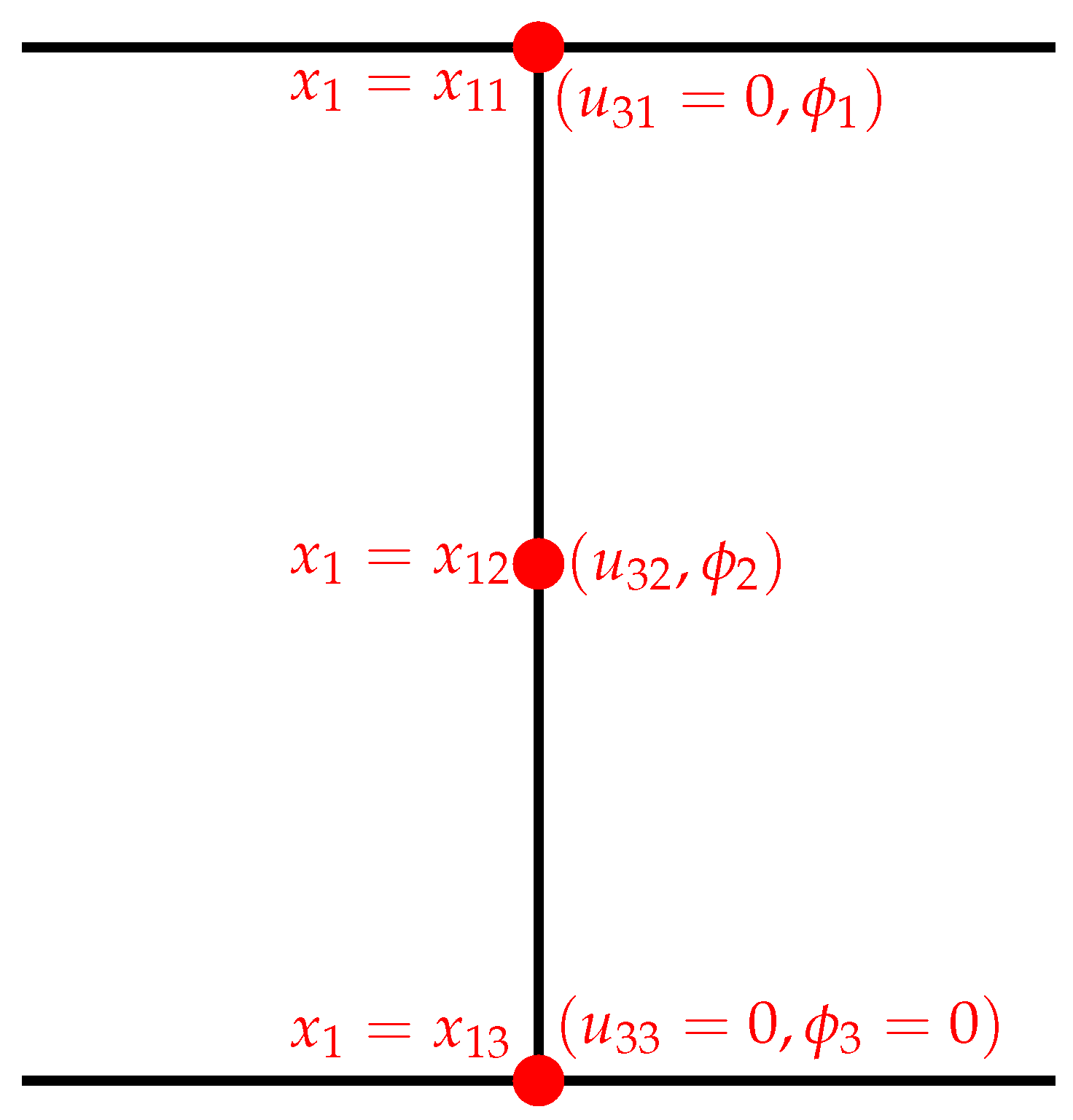
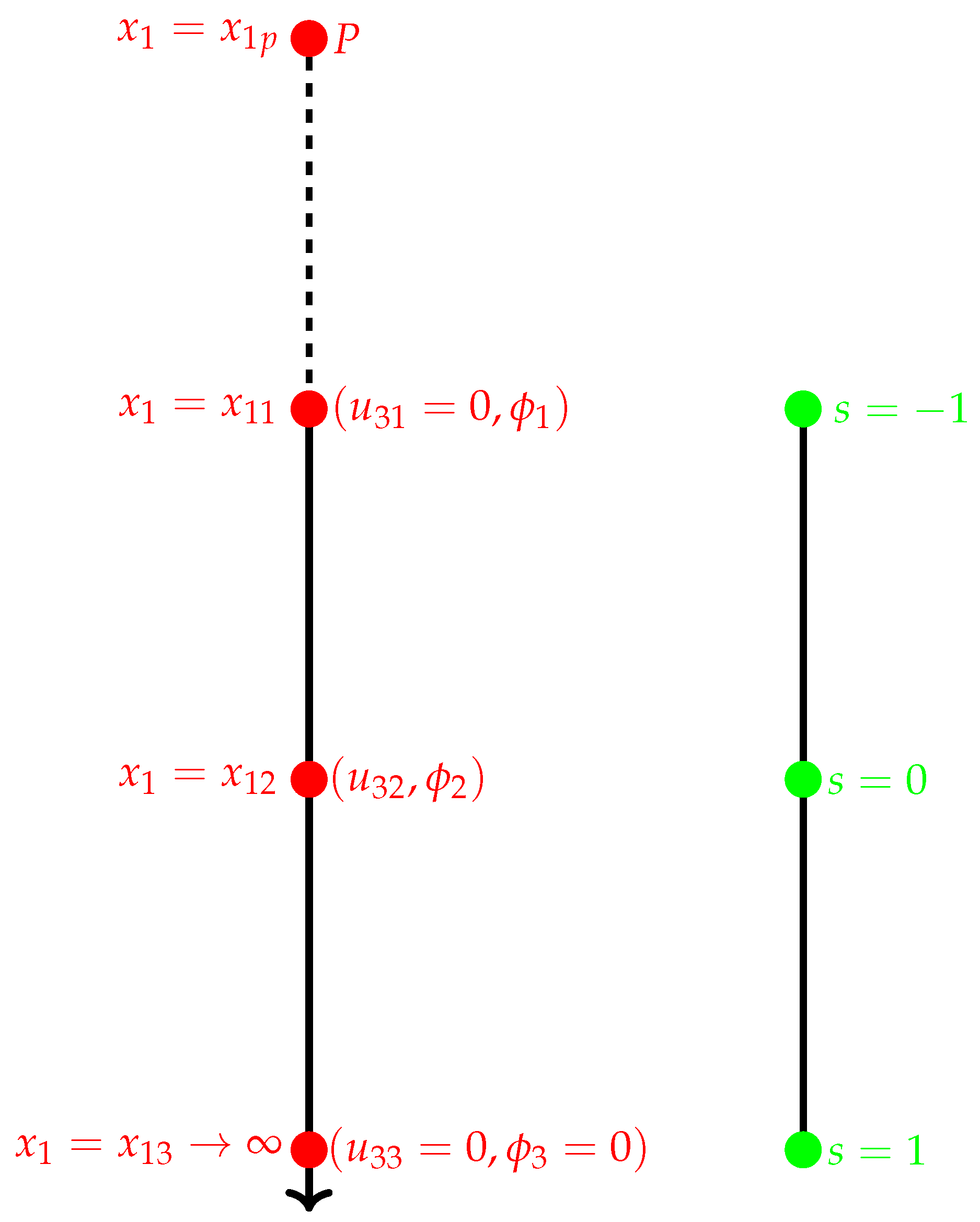
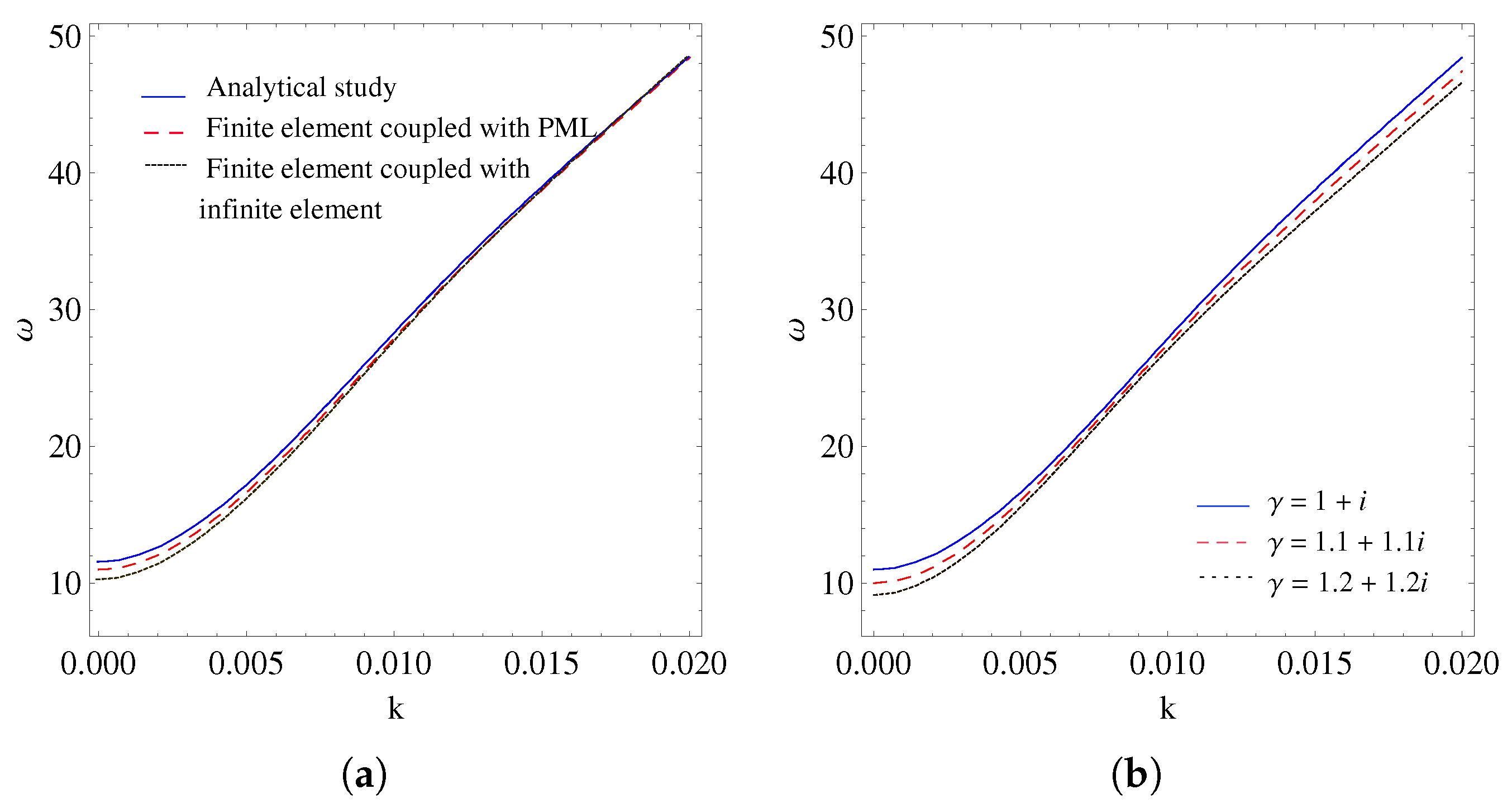
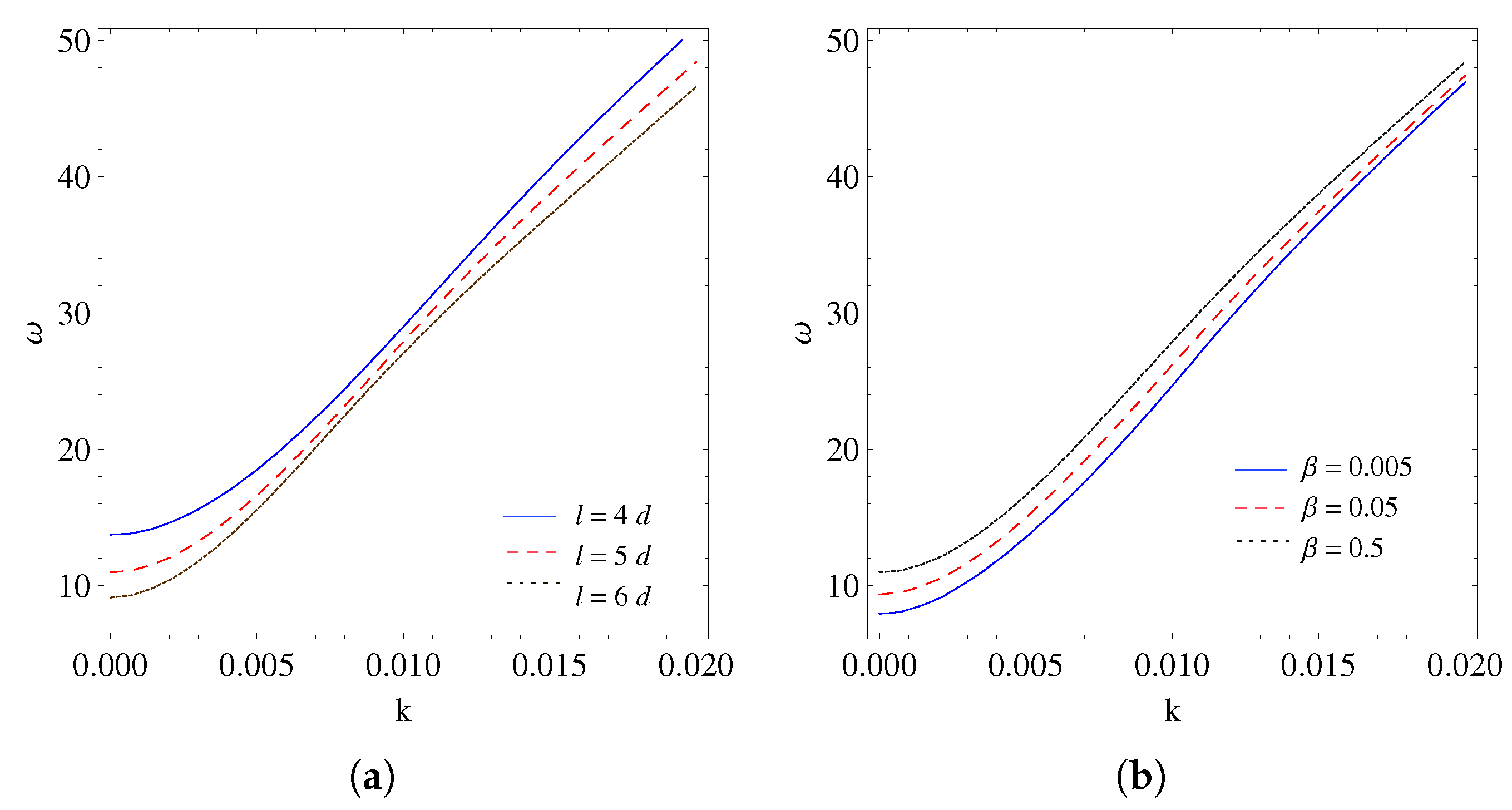
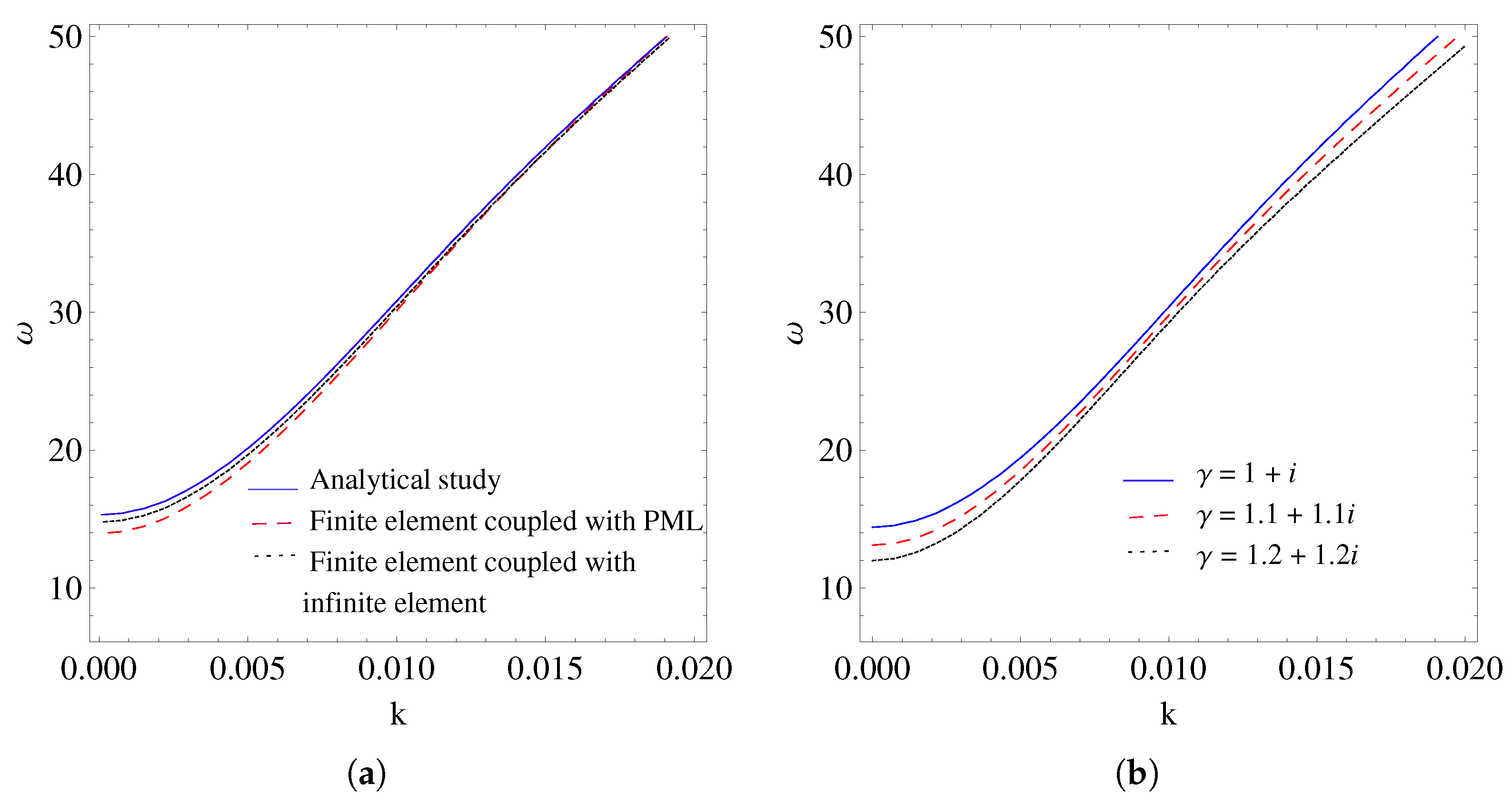
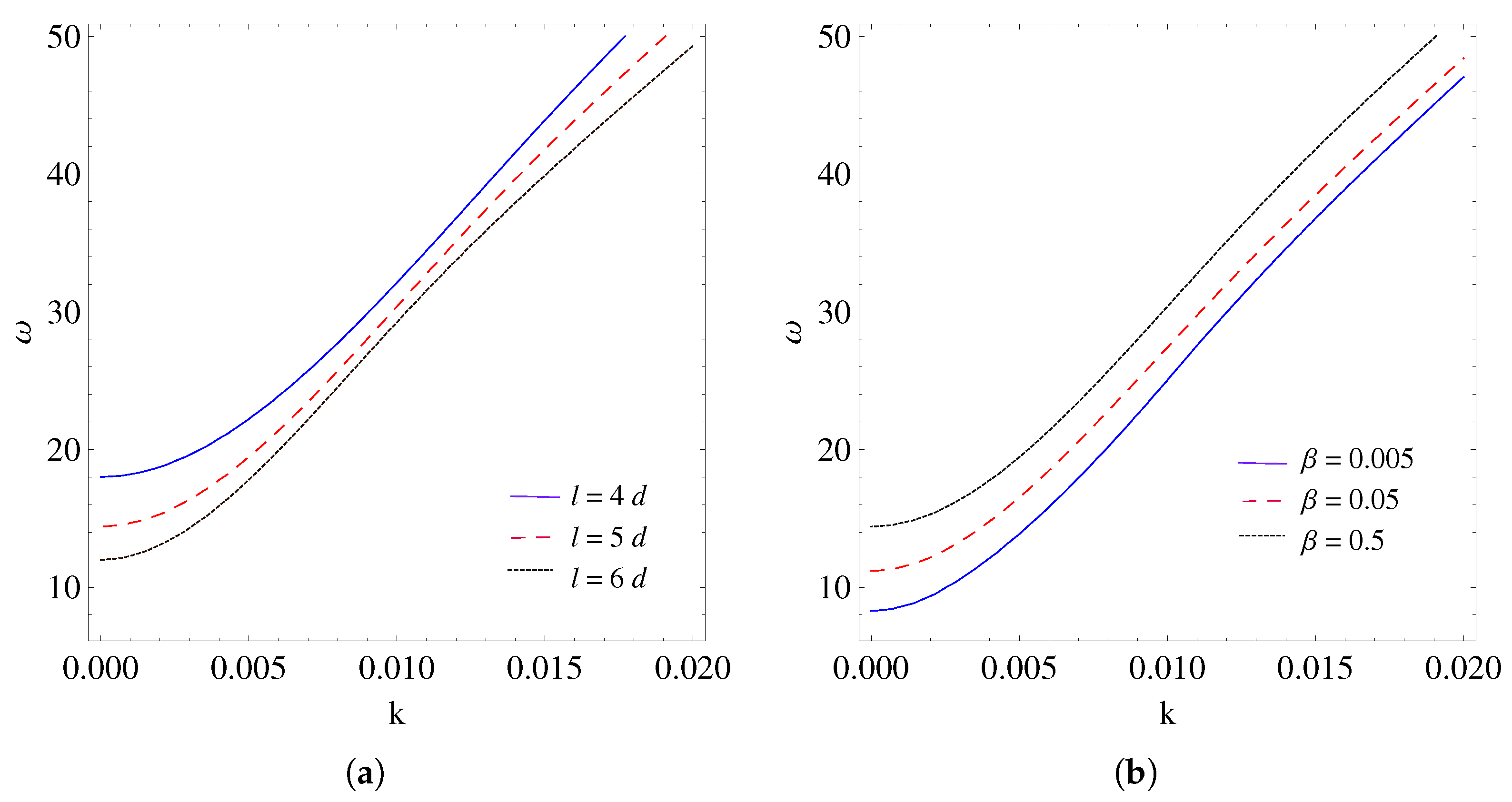
| Property | Symbol | Unit | Value |
|---|---|---|---|
| Elastic constant | 2.3 | ||
| Mass density | 7.5 | ||
| Piezoelectric constant | 17 | ||
| Dielectric constant | 277 |
Disclaimer/Publisher’s Note: The statements, opinions and data contained in all publications are solely those of the individual author(s) and contributor(s) and not of MDPI and/or the editor(s). MDPI and/or the editor(s) disclaim responsibility for any injury to people or property resulting from any ideas, methods, instructions or products referred to in the content. |
© 2025 by the authors. Licensee MDPI, Basel, Switzerland. This article is an open access article distributed under the terms and conditions of the Creative Commons Attribution (CC BY) license (https://creativecommons.org/licenses/by/4.0/).
Share and Cite
Hemalatha, K.; Akshaya, A.; Qabur, A.; Kumar, S.; Tharwan, M.; Alnujaie, A.; Alneamy, A. Transverse Wave Propagation in Functionally Graded Structures Using Finite Elements with Perfectly Matched Layers and Infinite Element Coupling. Mathematics 2025, 13, 2131. https://doi.org/10.3390/math13132131
Hemalatha K, Akshaya A, Qabur A, Kumar S, Tharwan M, Alnujaie A, Alneamy A. Transverse Wave Propagation in Functionally Graded Structures Using Finite Elements with Perfectly Matched Layers and Infinite Element Coupling. Mathematics. 2025; 13(13):2131. https://doi.org/10.3390/math13132131
Chicago/Turabian StyleHemalatha, Kulandhaivel, Anandakrishnan Akshaya, Ali Qabur, Santosh Kumar, Mohammed Tharwan, Ali Alnujaie, and Ayman Alneamy. 2025. "Transverse Wave Propagation in Functionally Graded Structures Using Finite Elements with Perfectly Matched Layers and Infinite Element Coupling" Mathematics 13, no. 13: 2131. https://doi.org/10.3390/math13132131
APA StyleHemalatha, K., Akshaya, A., Qabur, A., Kumar, S., Tharwan, M., Alnujaie, A., & Alneamy, A. (2025). Transverse Wave Propagation in Functionally Graded Structures Using Finite Elements with Perfectly Matched Layers and Infinite Element Coupling. Mathematics, 13(13), 2131. https://doi.org/10.3390/math13132131







